Clio gets her green laurel wreath back
Some of the green paint that Johannes Vermeer used in his masterpiece 'The Art of Painting' turned blue over the centuries. Researchers from the Kunsthistorisches Museum Vienna and the University of Antwerp studied this discoloration and approximated the color that the painter originally used. They applied a digital color reconstruction: the muse Clio gets back her green laurel wreath.
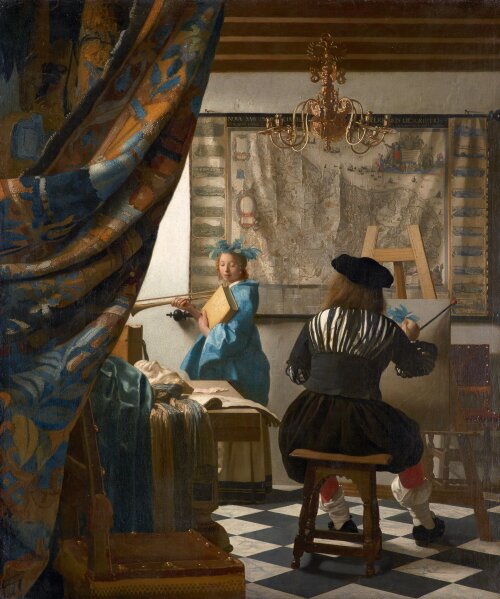
As with many Vermeer paintings, we see an interior scene in which the light enters from the left. The interior shows an idealized artist's studio. The painter - presumably Vermeer - is at work in front of his easel to capture the likeness of Clio, the Muze of History, on the canvas. We only see Vermeer from the back, dressed in a black silk-slit doublet.
'The Art of Painting' is one of the top paintings of the Kunsthistorisches Museum Wien and a one of the rare works of Vermeer in which you see the painter himself. Vermeer considered it to be his calling card. This painting is therefore very important in his oeuvre.
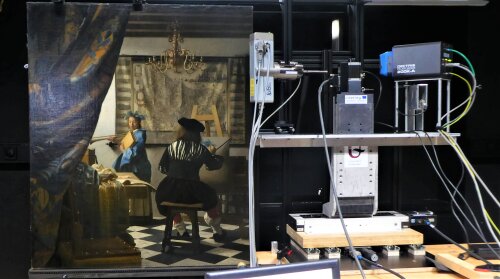
In October 2022, scientists from the University of Antwerp investigated this masterpiece of the 17th-century painter Johannes Vermeer with their self-developed MA-XRPD scanner. They did this upon the request of the Kunsthistorisches Museum (KHM), Wien, Austria. Earlier, the famous paintings 'The Girl with a Pearl Earring' (also by Vermeer) and 'The Night Watch' by Rembrandt were investigated with the same method. The complete "Art of Painting" research team consisted of Dr. Sabine Pénot, KHM curatorial department, Dr. Elke Oberthaler, KHM conservation department, Dr. Katharina Uhlir and Dr. Martina Griesser, KHM conservation science department next to Dr. Frederik Vanmeert and Prof. Koen Janssens, UAntwerp AXIS research group.

A striking aspect of the approximately 350-year-old paint is the discoloration from green to blue in some parts of this work. Dr. Frederik Vanmeert (University of Antwerp): "When you stand in front of the painting, the discoloration is most noticeable at the level of Clio's laurel wreath. Instead of shiny green, it is now the same color as her bright blue cloak. You get the impression as if Vermeer wanted to give Clio a headgear that was color-matching her dress." Other parts of the composition, such as the vegetal elements in the curtain in the foreground, also show similar color changes, but these are less noticeable.
Yellow fading away
On the basis of the analyses, it was possible to understand better what exactly happened with the paint mixture originally employed by Vermeer to create the shiny dark green of Clio's laurel. The researchers explain: “Vermeer used a mixture of Natural Ultramarine blue (the most expensive of all pigments, and very colorfast) and, we think, an organic warm-yellow dye to create the deep green glaze of the laurel. However, this dye was not able to withstand the ravages of time, causing the yellow color to fade and the shiny green to gradually turn blue.” The blue of the laurel that we see now is the same blue are in Clio's coat since Vermeer used Natural Ultramarine in both areas.
In the 17th century, Natural Ultramarine was made by grinding up lapis lazuli rocks that had to be imported from Eastern Afghanistan and thus was extremely costly. A fugitive yellow dye that Vermeer may have used is yellow weld or luteolin, aka as "Dyer's weld", an extract from Reseda Luteola.
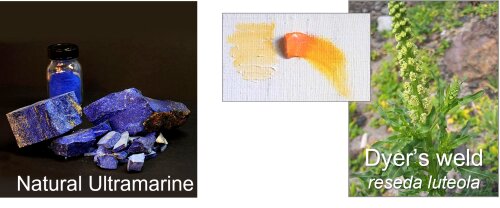
For the green of the lighter leaves in the laurel wreath, Vermeer employed a more stable mixture of Natural Ultramarine blue and the pale yellow pigment Lead Tin Yellow that largely retained its original color.
A more natural image
On the basis of these new insights, the researchers made attempts to approximate the color that the painter originally aimed for. By applying a digital color reconstruction they could give the muse Clio her green laurel wreath back ... at least on a computer screen.
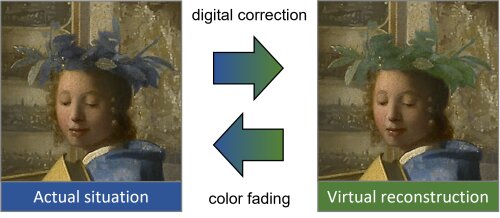
Prof. Janssens concludes: "The reconstruction produces a much more natural-looking image of Clio – we are fairly sure Vermeer originally painted her in this way." In the future, this method of digital color reconstruction might also be applied to other works by Vermeer.
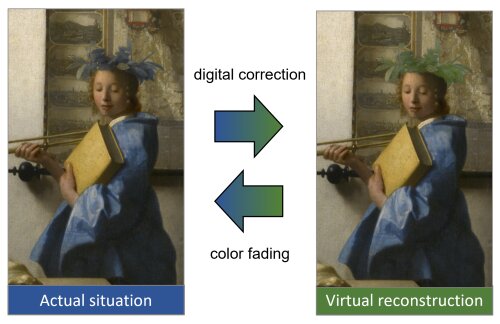
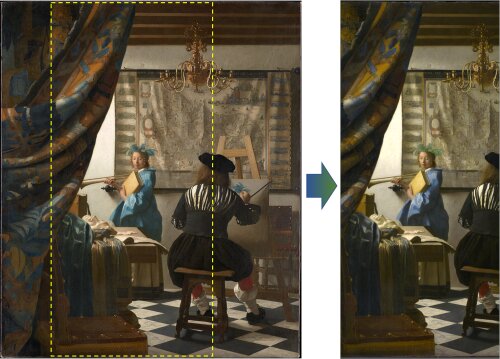
The results of this research will be presented on 28 March 2023 at an international scientific symposium on Vermeer's oeuvre, co-organized by the Rijksmuseum Amsterdam and the Mauritshuis Museum, The Hague in the margins of the major retrospective exhibition that is taking place from 10 February to 4 June 2023 in Amsterdam.
AXIS involved in major discoveries on Vermeer's painting The Milkmaid
A major Vermeer exhibition will launch in 2023 at the Rijksmuseum showing at least 27 paintings from the small oeuvre of about 35 works by Johannes Vermeer, coming from museums around the world. Before the start of the exhibition, several of Vermeer’s iconic works, such as The Milkmaid, are being investigated by a team of conservators, restorers and scientists from the Rijksmuseum and the Mauritshuis (press release Rijksmuseum). Next to state-of-the-art scientific techniques, such as Macroscopic X-ray fluorescence mapping (MA-XRF) and Reflectance Imaging Spectroscopy (RIS), also Macroscopic X-ray diffraction (MA-XRPD) is performed using a unique instrument developed within the AXIS research group (University of Antwerp).
With their MA-XRPD scanner the AXIS group examined a series of Vermeer paintings within the Rijksmuseum, including The Milkmaid and The Love Letter, not only to look at the original pigments and paintings techniques used by Vermeer but also to search for clues in order to understand the discoloration phenomena that take place in these works of art since their completion 350 years ago. From the Mauritshuis collection, two paintings by Vermeer were previously examined with MA-XRPD: Girl with a Pearl Earring and Diana and her Nymphs.
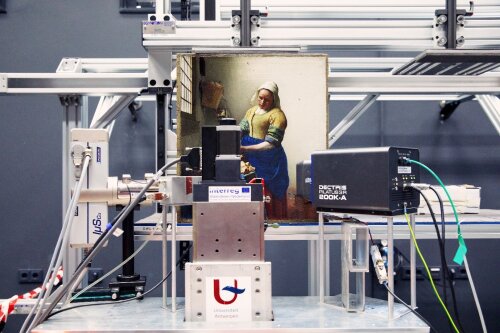
Vermeer's The Milkmaid being examined with the AXIS MA-XRPD scanner (University of Antwerp). Credit: Rijksmuseum, Amsterdam
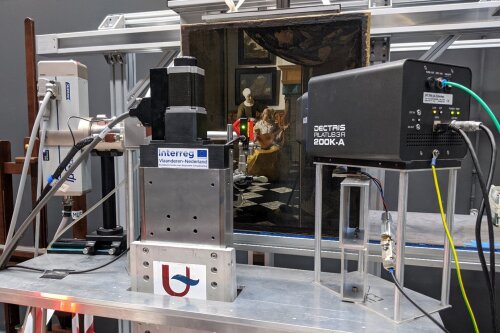
Vermeer's The Love Letter being examined with the AXIS MA-XRPD scanner (University of Antwerp). Credit: F. Vanmeert
A movie of the Rijksmuseum on the second part of the research project can be found here and of the third part here.
Additional media attention:
Vermeer paste Melkmeisje aan: schilderij toonde eerst vuurmand en rek met kannen - NOS Nieuws, 08-09-2022
"Het melkmeisje" geeft na 360 jaar nog geheimenprijs: Vermeer schilderde eerst veel drukker decor- VRT 08-09-2022
Vermeer - Een onderzoeksproject, deel III (rijksmuseum.nl)
Previous research
In 2018 a series of state-of-the-art scientific techniques were used for the investigation of another famous work by Vermeer in the collection of the Mauritshuis: Girl with a Pearl Earring.
Within ‘The Girl in the Spotlight’, a joint project of several institutions within the framework of the Netherlands Institute for Conservation, Art and Science (NICAS), AXIS used their MA-XRPD scanner to reveal Vermeer’s use of different types of the pigment lead white when creating bright highlights or dark shadow tones, which was published within Science Advances.
In a special issue of Heritage Science completely devoted to the research on Girl with a Pearl Earring, the results of the technical examination are revealed in (up to now) 10 scientific papers. With the AXIS MA-XRPD scanner different degradation products such a sulfates and oxalates of Ca, Cu, Pb ... could be identified on the surface of the dark background (published in Heritage Science).